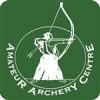Archery tips and comments.
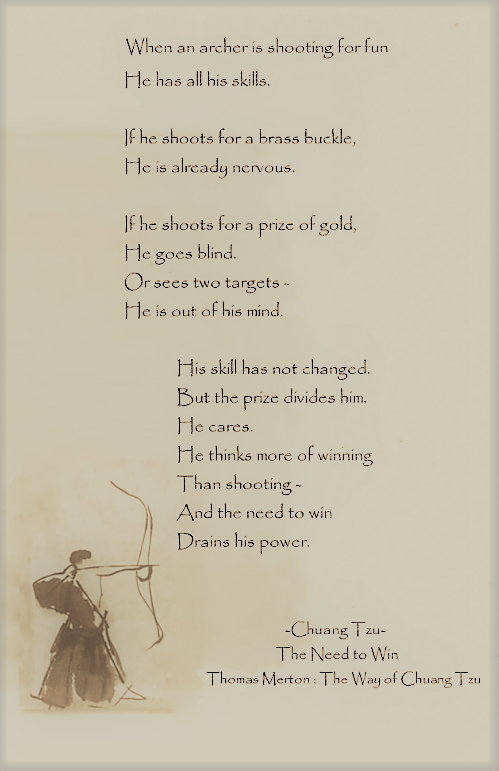

Nobody cares how much you know, they want to know how much you care.
Here is a link to the World Archery website and an article on ten things every new
(and many experienced) archers should know.
https://worldarchery.org/news/131737/10-things-every-new-archer-should-know
What is brace height?
Brace height is the distance between the deepest part of the handle and the string, many people also measure from the pressure button to the string which is in most cases the same.
Brace height is critical in two areas – arrow speed and bow forgiveness.
Generally speaking, a shorter brace height helps a bow generate more arrow speed. Let's say you took two bows of 30 pounds draw weight, with a 28-inch draw length, and one has a 7-inch brace height and the other 9 inches. If you shot the same arrow from both bows, the bow with the 7-inch brace height should shoot the arrow faster than the other. A bow’s forgiveness relates to accuracy. A forgiving bow minimizes an archer’s mistakes, while an unforgiving bow magnifies them.
Bows with shorter brace heights tend to be less forgiving than those with longer brace heights, because the string is in contact with the arrow for a longer period. An archer therefore has to maintain perfect form for a longer stretch, until the arrow is in the air.
Suggested brace heights, experiment for best performance.
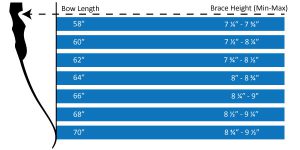
How does tiller affect arrow flight?
Poor tiller set up will show up most noticeably as a noisy bow, your limb tips will not stop moving after the shot and you may both feel and see vibration in the limbs. All of this results in an inconsistent bow, poor arrow flight and worse sight marks.
As a reminder,
"Tiller” is the difference in distance between where the top and bottom limbs, respectively, meet the riser and bowstring. The top and bottom tillers differ slightly because you do not pull on the bowstring's exact center when drawing the bow.
(This may not apply if you shoot three fingers under or string walk.)
What is "String Picture"?
We often hear or read about the "String Picture" but what exactly does that mean? the string picture is important to recurve/longbow/barebow/traditional archers as it forms a major component in the aiming process, equal to the rear sight on a firearm. When using a front sight we have a pin/post/dot circle or crosshair to place on the target, this is not much help unless we have a rear reference point as well. Those of us who shoot compound have the peep in the string to look through giving us a consistent line of sight. Archers who prefer one of the other styles of archery must use the string (minus the peep) as the rear reference. The series of pictures below will help to explain this.
K.
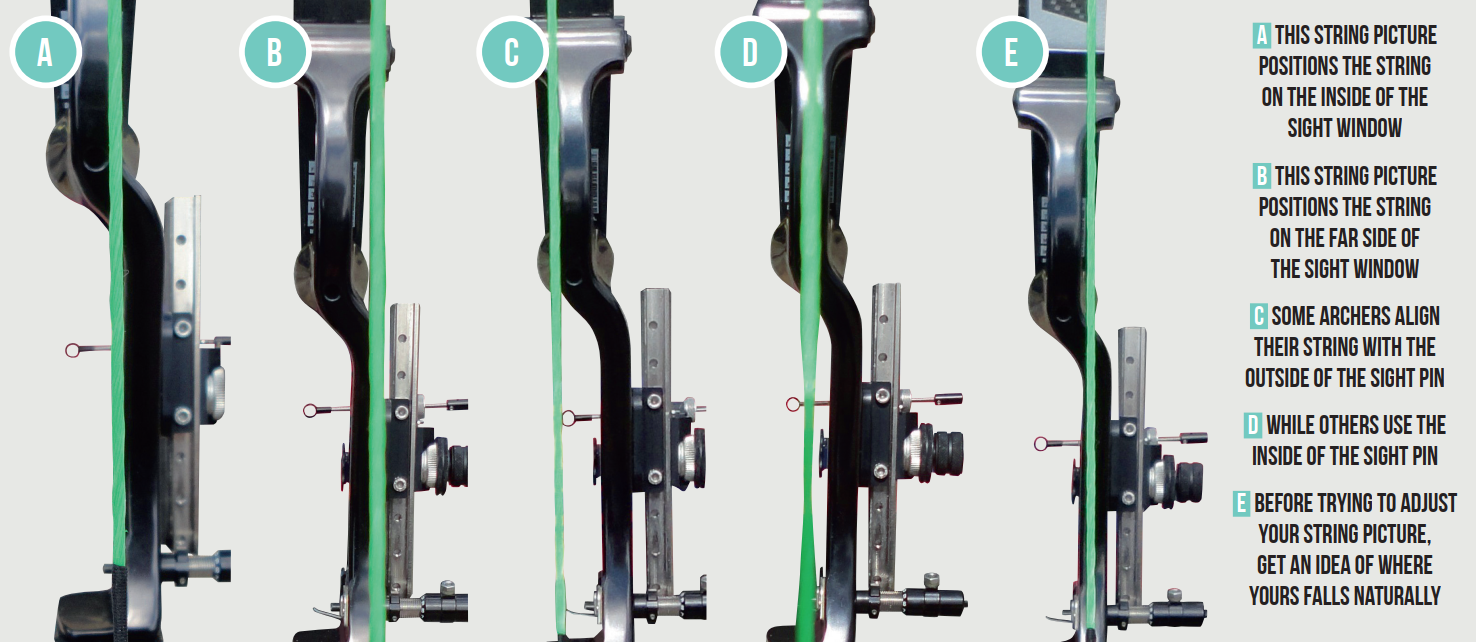
What is a plunger button?
A plunger button is a fine tuning device with an adjustable spring cushioned tip inside a housing. The plunger button is installed on the riser with the tip protruding above the arrow rest and its purpose is to push the arrow to the left, on a right hand bow, to compensate for archers paradox. The side of the arrow is in contact with the plunger button tip when the arrow is sitting on the arrow rest.
The spring is tuned to allow a certain amount of movement of the arrow towards the riser on release of the arrow, bringing the arrow to the ideal
"centre shot" location. The plunger button is used to compensate for the arrow's flex, since the arrow flexes as the string pushes onto it with a very high acceleration, creating what is known as the archers paradox.
A recurve must have a threaded hole or sleeve in the riser to accept a plunger button.
The arrow rest needs to be positioned so that the centre of the arrow and the centre line of the pressure button line up.
Fine or micro tuning of the plunger button is arguably one of the most critical steps when tuning the recurve bow.
The tip of the plunger is susceptible to extensive wear and to prevent tips wearing out some tips are made of durable materials like teflon. Invariably new archers cannot justify spending a lot on a plunger and opt for an entry level model, which is at the right price but its tip wears quickly and replacements are not available, so a new plunger must be purchased.
Similarly, the spring in an entry level plunger will be rough or not compress smoothly as it is built to a price with cheaper springs that will not hold up over time. Better quality buttons are much easier to adjust as the springs are made of superior material and can take the stress of thousands of shots, will respond to micro adjusting and never relinquish their tension.
Once the plunger is fine tuned, rarely would the button need to be re-adjusted. A high quality plunger is a good investment as it will last a lifetime.
Greater acuracy comes with quality buttons, it is claimed four out of five olympians use a Beiter plunger button.
The plunger is also known as a pressure button or Berger button, invented by tournament shooter Norman Pint but named after well known archer Victor Berger.
Source: AbbeyArchery
What is the anchor point?
The anchor point is a spot on your face that your bow string hand---or the string itself---should touch when you're at full draw.
The anchor point is crucially important, because having a single spot to which you routinely draw means that you will be able to aim with consistency. Without an anchor point, it is absolutely impossible to consistently hit a target.
Anchor Points and the recurve bow:
A good spot for beginners using a recurve bow could be the corner of your mouth, when you're at full draw, the index finger on your draw hand could touch the corner of your mouth because it's easy to remember, easy to reach, and easy to repeat time after time.
For more advanced archers, If you're watching any archery competition, you may see archers use an under-the-jaw anchor (and if you watch the Olympics, you'll see a lot of under-the-jaw anchors). The under-the-jaw anchor gives competitive archers more points of reference: they can feel their hand underneath their chin, the string at the same spot on their lips, and the string on their nose. After extensive practice, they build up a sense memory of where the string should be at each point, and are able to draw the bow exactly to the same spot time and time again---which translates to more accuracy and consistency. Below, South Korean Olympic gold medalist Ki Bo-bae uses an under-the-jaw anchor that comes to the tip of her nose, the middle of her lips, and just under her jaw.
While we are looking at this archer, look closely at her bow hand, the position of the bow against the soft part at the base of the thumb, not in the palm of her hand, knuckles at 45 degrees, The relaxed state of the fingers, the slightly bent bow arm and the lowered bow-arm shoulder, great form.
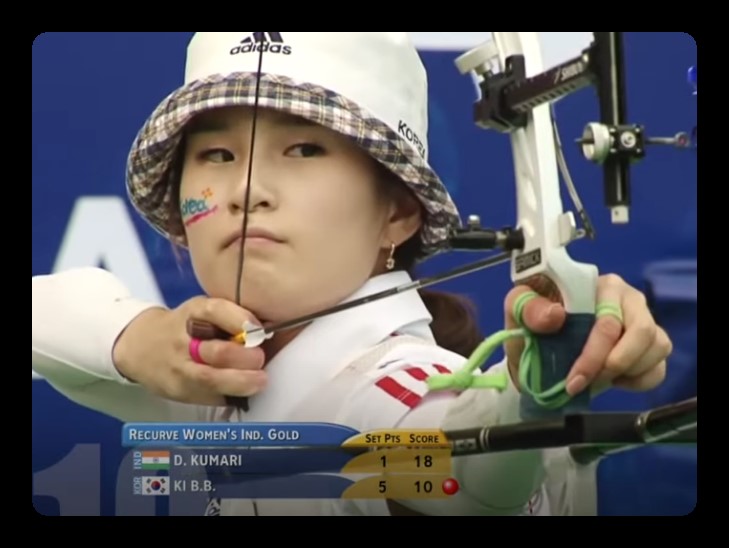
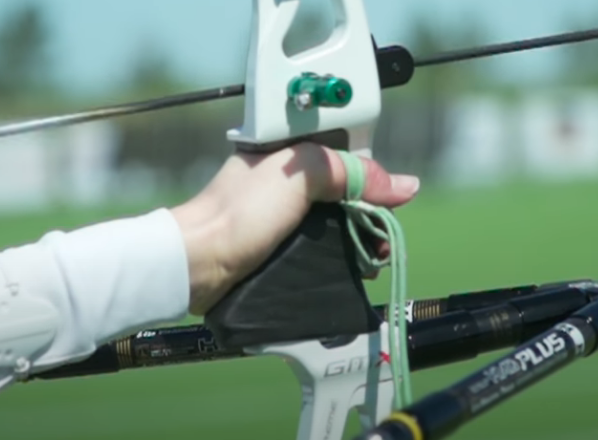
Bow Grip:
The way we hold the bow is very important, if we hold the bow in a tight grip, not only have we created tension that will be released on the loose causing the bow to move, affecting arrow flight, but the forearm is now in danger of being struck by the string, this is painful, but worse, it seriously affects accuracy. Study the pictures below, if the bow is held with the knuckles at a 45 degree angle and a finger sling is used the bow cannot fall, so no need to hold tight or grab at the moment of loose, also the forearm is rotated out of the string path so cannot be hit. Work on the bow hand grip will be rewarded with greater accuracy. Note that the thumb is pointing at the target when the grip is correct..
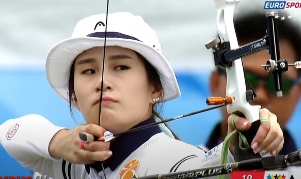
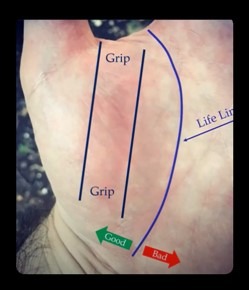
Aiming the recurve bow:
Horizontal Impact
For those compound shooters who, like myself are fascinated/obsessed with the technical aspects of archery, John Dudley explains his HIL
(Horizontal Impact Line) method of tuning a compound. Don't be put off by the constant reference to Easton ProTours if you use another brand, as the method will still work.
The effect of twisting / untwisting string and cables on your compound bow.

